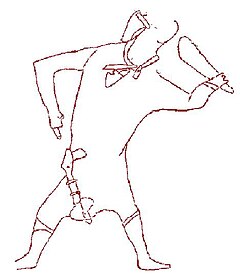La Marche (cave)

La Marche Cave painting
|
|
| Location | Lussac-les-Châteaux |
|---|---|
| Region | department of Vienne, western France |
| Coordinates | 46°24′22″N 0°43′28.6″E / 46.40611°N 0.724611°ECoordinates: 46°24′22″N 0°43′28.6″E / 46.40611°N 0.724611°E |
La Marche is a cave and archaeological site located in Lussac-les-Châteaux, a commune in the department of Vienne, western France. It is an archaeological site that has engendered much debate that has not been resolved to date. The carved etchings discovered there in 1937 show detailed depictions of humans and animals that may be 15,000 years old. The cave paintings at this site, however, are controversial and many doubt their authenticity.
The La Marche cave is located in the Lussac-les-Châteaux area of western France. It is at the bottom of a small valley bordered by the Petit Moulin river. It most likely is the result of the underground tunneling of the river. Of the 350 known sites of European cave art from the Ice Age, almost half are located in this country. In addition to La Marche, several other important cave sites from the Paleolithic period have been discovered in France including those at Lascaux, Niaux, Trois Frères, Font-de-Gaume and Les Combarelles, Chauvet, Cosquer, Cussac, and Rouffignac.
The artwork found in La Marche is specifically from the middle Magdalenian period, dating to approximately 14,000 or 15,000 years before the current era (BCE). Factors that made La Marche an ideal archaeological site for artwork include its usefulness as a shelter to prehistoric humans, the cultural preferences of these early people, and its relatively good preservation.
The La Marche cave paintings were discovered in the caves in the Lussac-les-Châteaux area of France by Léon Péricard in November 1937. Péricard, and his partner Stephane Lwoff, studied these caves for five years and found etchings on more than 1,500 slabs. In 1938, they presented their discovery to the French Prehistoric Society, and published them in the Society's Bulletin. Many people questioned the validity of these findings, however, stating that they made that judgment because the paintings closely resembled modern art.
...
Wikipedia

